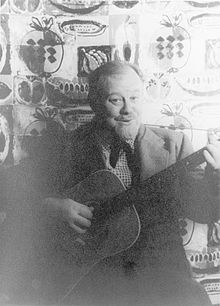Lavender Blue
Lavender Blue (alternate title Lavender Blue (Diddle Diddle) and Lavender's Blue ) is a song by Eliot Daniel (music) and Larry Morey (lyrics) based on an English folk song and released as a Disney film song in 1949 .
The folk song
The earliest version of the song appeared in a song sheet printed in England between 1672 and 1685 under the title Diddle Diddle, Or The Kind Country Lovers . In the song, the singer tells his beloved that she must love him because he loves her so much. The first lines of the song are:
Lavender's green, diddle, diddle,
Lavender's blue
You must love me, diddle, diddle,
cause I love you,
I heard one say, diddle, diddle,
since I came hither,
That you and I, diddle, diddle,
must lie together.
This resulted in the nursery rhyme from the song collection Songs for the Nursery (1805):
- Lavender blue and Rosemary green,
- When I am king you shall be queen;
- Call up my maids at four o'clock,
- Some to the wheel and some to the rock;
- Some to make hay and some to shear corn,
- And you and I will keep the bed warm.
Similar versions appeared in collections of rhymes during the 19th century.
The film editing and cover versions

Daniel and Morey edited Lavender Blue for the Walt Disney production A Champion to Love (Original title So Dear to My Heart. 1949, directed by Harold D. Schuster and Hamilton Luske ). In the lead roles, the child actor played Bobby Driscoll and Luana Patten as well as in the role of Uncle Hiram Douglas folk singer Burl Ives , who also Lavender Blue presents in the film. The song received an Oscar nomination for Best Song in 1950 .
Capt. Stubby & The Buccaneers released the song Lavender Blue (Dilly Dilly) on Brunswick (04066), coupled with Billy Boy and on (Disneyland 130) coupled with the Mary Poppins song Chim Chim Cheree . As early as 1944, numerous cover versions of the song were made in the field of popular music, including a. in England by Donald Peers ( His Master's Voice B.9772), Joe Loss and His Orchestra (vocals: Elizabeth Baley; HMV BD6043) and in the United States by Sammy Kaye (Victor 203100), Margaret Whiting , Vera Lynn (London 310) and Dinah Shore (Columbia 38299), who had a number one hit in Australia in 1949-50 with Lavender Blue . In 1959, a soul version by Sammy Turner (Bigtop 45-3016) was produced by Jerry Leiber and Mike Stoller . As early as 1949, several jazz musicians interpreted the song, including Lester Young and Shep Fields and His Rippling Rhythm Orchestra. The song was recorded in later years by Bobby Vee (1961), Eddie Barefield (1962), Bobby Vinton (1964), Leon Russell ( Wedding Album. 1976) and adapted by the British rock band Marillion ( Misplaced Childhood . 1985). In May 2016, a recording by Victoria-Luise Mey was included on the CD with the title “Mr. Lee ”by her father Reinhard Mey .
Web links
- Inclusion in the catalog of the German National Library: DNB 1022614924
Individual evidence
- ↑ Diddle Diddle, Or The Kind Country Lovers .
- ^ Traditional Ballad Index
- ↑ a b c I. Opie and P. Opie, The Oxford Dictionary of Nursery Rhymes (Oxford University Press, 1951, 2nd edn., 1997), pp. 265-7.
- ^ The 1950 Oscars in the Internet Movie Data Base
- ↑ a b c Billboard July 30, 1949
- ↑ Lavender Blue on Allmusic (English)
- ↑ Lavender Blue on Allmusic (English)
- ^ Australian Chart Book by David Kent
- ↑ Lavender Blue on Allmusic (English)
- ↑ published on Affinity AFF 80, Lavender Blue by Allmusic (English)
- ↑ Tom Lord: The Jazz Discography (online, accessed January 18, 2014)
- ↑ Lavender Blue on Allmusic (English)
- ↑ Lavender Blue on Allmusic (English)